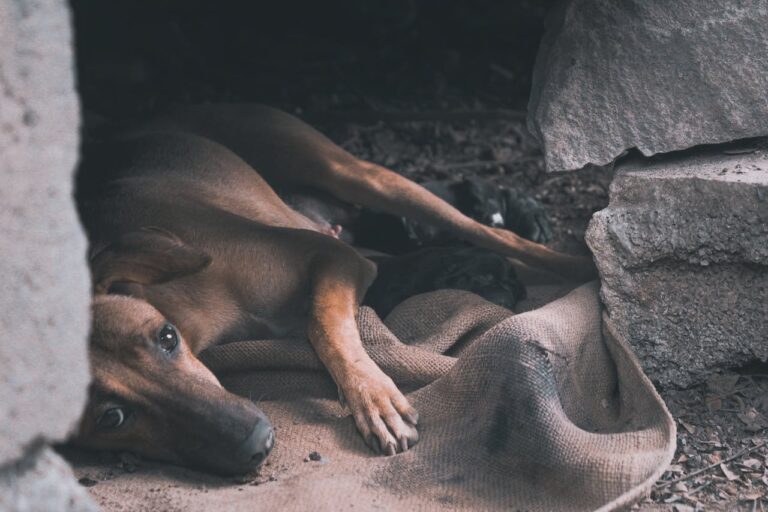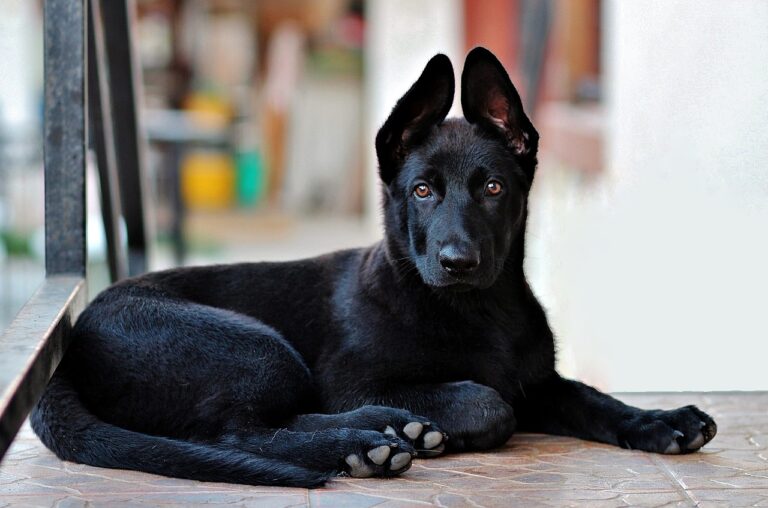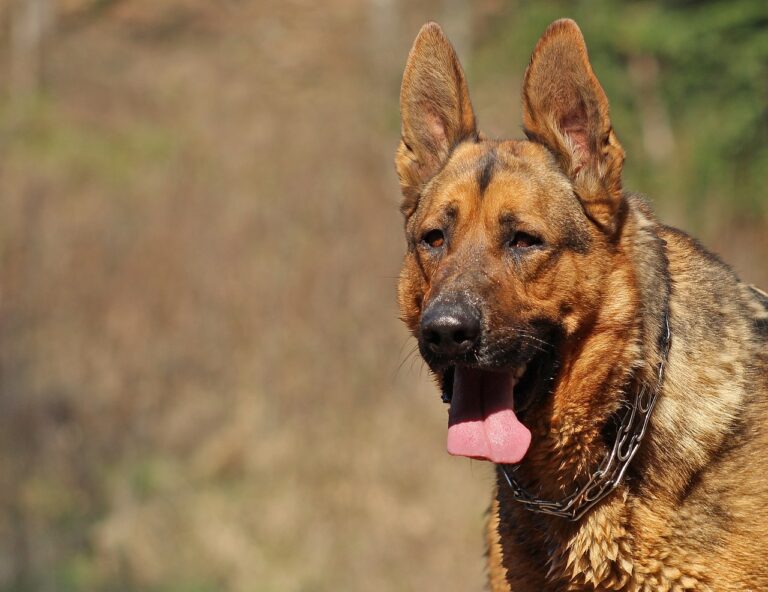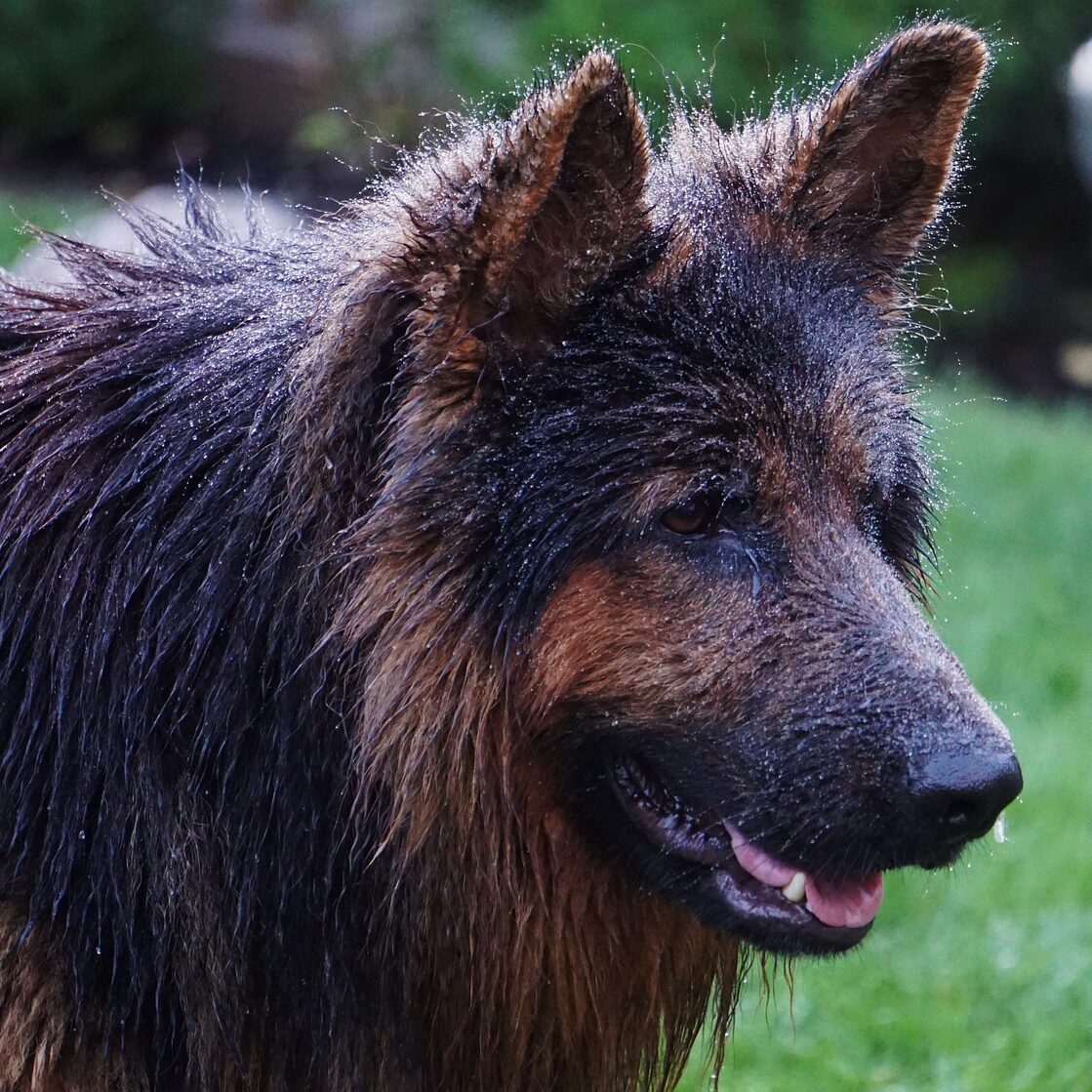
Bathing is a very fun and rewarding job that offers you the opportunity to bond with your adorable snuggle bud. But, unfortunately, your German Shepherd might not love the whole grooming process, becoming agitated and resisting your efforts to groom him. If that is the problem you face, no need to worry. In this post, we will consider how to properly handle the whole dog bathing process to ensure it’s rewarding for both you and your German Shepherd.
When you Bathe your German Shepherd Dog, you need to…
- Prepare the bathing area
- Get your GSD used to the bathing area.
- Use a Leash Grooming Table (If Possible).
- Get assistance.
- Block off the ears.
- Thoroughly hose down your German Shepherd.
- Completely shampoo your dog
- Thoroughly rinse and dry off your GSD.
- Clean Your dog’s ears.
- Trim and brush down your GSD’s Coat
These steps might seem overwhelming, and they can be if not done correctly. So I implore you to patiently read as I show you the best way to carry out each of these steps. We’ll divide the steps into three stages: before, during, and after bathing. Let’s start with the first step before bathing: Prepare the bathing area.
Table of Contents
Before You Bathe Your GSD
1. Prepare where you will bathe your German Shepherd.
This is a very important step. Choosing and properly preparing where you want to bathe your German Shepherd will determine how stress-free and successful the whole process will be. So I recommend thinking deeply about this first step. Ideally, you want to choose a location that has enough space and is comfortable for you and your German Shepherd.
How to Do It
- Choose a clean and spacious location: If you have a smaller dog, a bathtub will do just fine. For older dogs, try finding a position where you can restrain your dog. Ideally, choose a location where both you and your dog are comfortable.
- Ensure you have enough water: For a stress-free bathing experience, we recommend you bathe your German Shepherd close to a water source. This could either be a tap, hand shower (if you are comfortable bathing your dog indoors), or a big bucket of water.
2. Get your GSD Familiar with the Bathing Area.
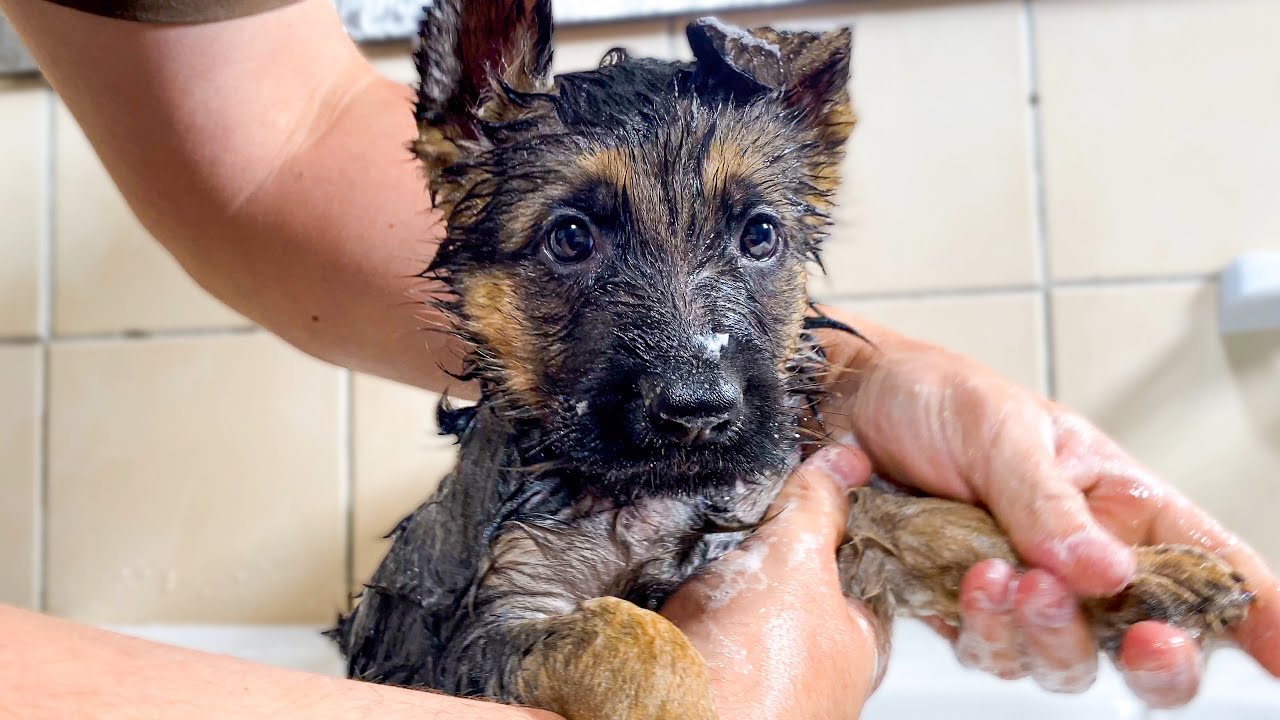
If this is the first time you will be bathing your German Shepherd, chances are, it will be restless during the whole process. One way to reduce the stress or anxiety your dog might have is to introduce it to the bathing area beforehand. Allow your dog to explore and familiarize themselves with the area.
It is important to note that though this will reduce your German Shepherds’ anxiety, it might not get rid of it completely. This is because some German Shepherds are naturally afraid of water and being handled. So, as much as possible, allow your dog to explore and get comfortable around the bathing area.
How to Do it
1. Positive Introduction
- Start by allowing your dog to explore the bathroom and around the bathing area when it’s not bath time. Use treats, toys, and positive reinforcement to create a positive association with the space.
2. Gradual Exposure to Elements
- Introduce elements of bath time one at a time. Let your dog see and sniff the bathtub without water, then gradually add water. Use treats and praise to reward calm behavior.
3. Short, Positive Sessions
- Keep the initial sessions short and positive. Spend a few minutes in the bathroom, gradually increasing the time. Reward your dog for calm behavior during and after each session.
4. Positive Associations with Water
- Turn on the water briefly to get your dog used to the sound. Use treats and praise during this process. Slowly introduce your dog to the sensation of water on their paws and body.
5. Consistent Positive Reinforcement
- Establish a consistent routine for bath time, and always reinforce positive behavior with treats, praise, or play. Consistency helps your dog feel more comfortable and secure during the bathing experience.
Remember that the goal is to get your dog as comfortable as possible in the bathing environment. Make sure to only make positive memories in that spot so your dog is always happy to be there for long periods.
3. Use a Leash and Grooming Table (If Possible).
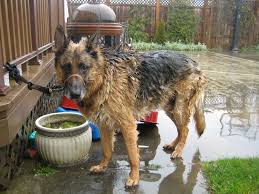
If your German Shepherd is well-behaved and trained, you can use a leash to control their movements during the bath. Attach the leash to a secure anchor point, ensuring it is long enough for them to stand comfortably. This equipment will give you more control and confidence when bathing your dog.
If you are not a fan of having to restrain your dog during bathing, you must get your dog used to it at an early age. Watch the video below for help with that, as Zack Goarge shows you how.
4. Get Someone to Assist You with the Bathing Process.
When may you need assistance bathing your dog? There are a lot of situations and factors that will determine that. Here are a few below.
- Size and Strength: Larger or stronger dogs may be more challenging to handle during bath time. Having someone else to help restrain or control the dog can make the process smoother and safer.
- Anxiety or Fear: Some dogs may be anxious or fearful during bath time. Having an extra pair of hands to comfort and reassure the dog can be beneficial. It also helps to have someone who can keep the dog distracted with treats or toys.
- Health Issues: If your dog has health issues, such as arthritis or mobility problems, they may require extra support during the bathing process. Assistance can help ensure the dog is comfortable and doesn’t experience any unnecessary stress or strain.
- Behavioral Challenges: Dogs with behavioral challenges may require additional support. Aggressive or overly excitable dogs may benefit from having someone else present to assist with control and handling.
- Handling Equipment: Bathing often involves using various tools and equipment such as hoses, sprayers, or special shampoos. Having an extra set of hands can make it easier to manage these tools while ensuring your dog’s safety and comfort.
- Injury or Disability: If you have a physical injury or disability, you may find it difficult to manage the bathing process alone. Assistance can be crucial in such situations to ensure both you and your dog are safe.
- Complex Grooming Needs: If your dog requires more than a simple bath, such as nail trimming, ear cleaning, or brushing, having assistance can make it easier to address all of your dog’s grooming needs thoroughly.
It is important to note that dogs don’t necessarily react the same way to water. Your dog might love it or not. So if you are unsure of the level of assistance you might need, it’s always safe to have someone on hand. For more personalized help, feel free to consult a professional groomer or your vet.
5. Block off your dogs’ ears
This is very important to ensure soap water does not enter your dog’s ears, as this could either damage your dog’s eardrums or cause an ear infection.
How to DO it
- Simply cover your dog’s ears using an ear cover or protector for dogs. You could also use a dry cloth that does not easily absorb water. Remember to avoid pouring too much water on your dog’s head to reduce the risk of water entering your dog’s ears.
We recommend having this head and ear cover on before you begin bathing your dog as you might forget it completely when you get yourself immersed in the bathing of your dog.
Useful Equipment
- A dog leash
- Grooming Kit
- Ear covers
- Grooming table
During the Bath
6. Thoroughly Hose Down Your GSD
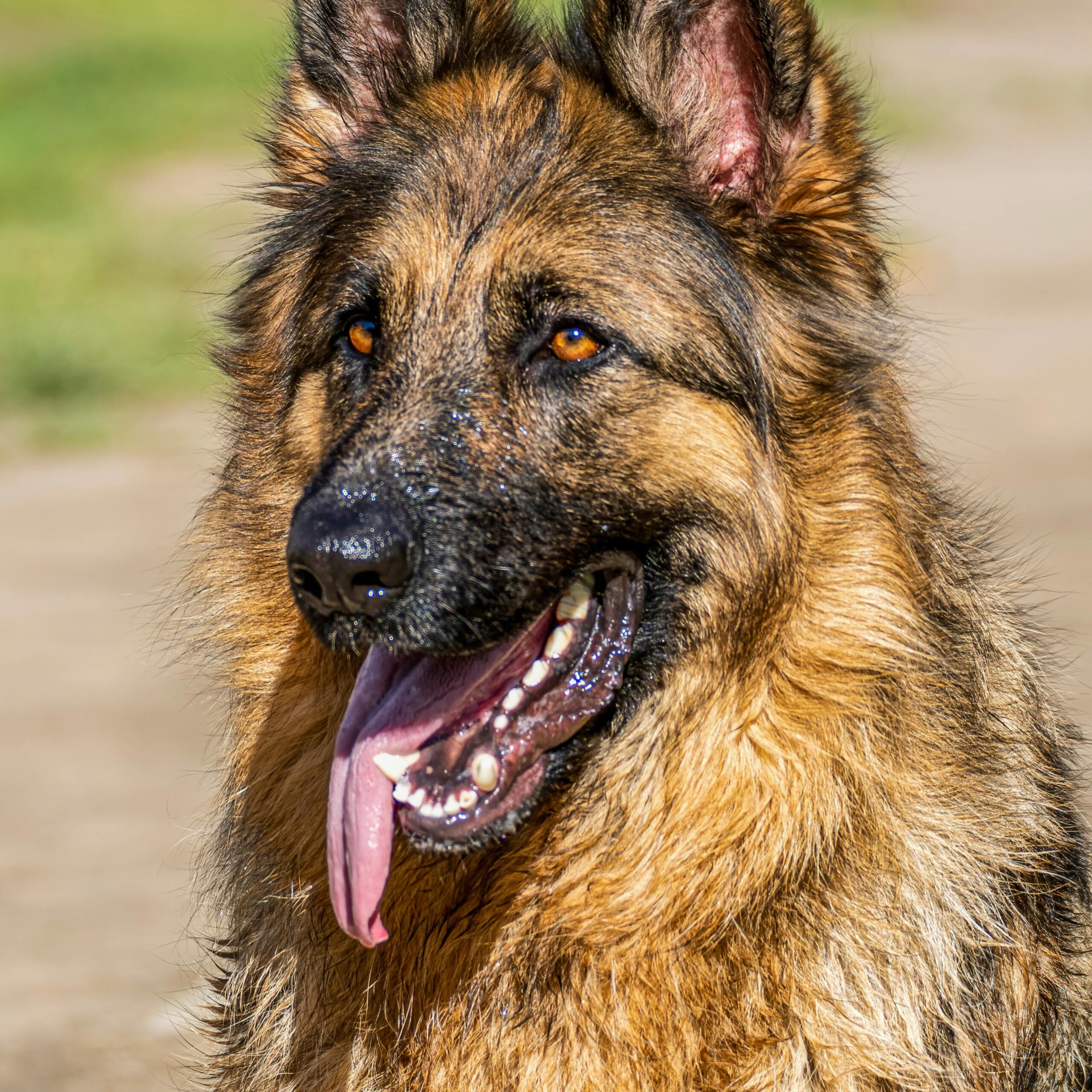
You want to get your dog as wet as possible. This will make it easier to apply your soap and shampoo solution.
How to Do it
- Use a hose connected to running water for a large dog, or a bowl of water gently poured on all parts of the body for a much smaller dog.
- Make sure the water reaches all parts of your German Shepherd’s coat and completely drenches both the external and double coat underneath.
- You can achieve this by spending enough time on each section of your dog’s coat with soft running water. Spending 10 to 15 seconds on each section of your GSD’s coat should do the trick.
I recommend using a shower mouth for your hose as this provides the best results. This also better mimics the feel of raindrops which should reduce your dog’s stress levels significantly when compared to direct water pressure from a regular hose.
7. Use Shampoo When You Bathe Your Dog
Once your GSD’s coat has been drenched with water gently apply shampoo on your dog’s coat. The shampoo should foam up on your dog’s coat.
How to Do it
- Once the coat is wet, apply an appropriate amount of dog shampoo. It’s essential to use a shampoo specifically formulated for dogs, as human shampoos may contain ingredients that can be harsh on a dog’s skin.
- Starting from the neck and moving toward the tail, work the shampoo into the coat using gentle massaging motions. Pay attention to areas where dirt, oil, or odors may be concentrated, such as the neck, back, and hindquarters. Be cautious around sensitive areas like the eyes and ears.
–
- If your German Shepherd has a double coat, make sure to lift and separate the fur to reach the skin and ensure thorough cleaning. Use a sponge or washcloth to clean the face, being careful around the eyes and ears.
- Follow the instructions on the shampoo bottle regarding the amount to use and the recommended duration for leaving the shampoo on the coat before rinsing.
Once you have completely shampooed your dog, scrub well to ensure the shampoo penetrates every layer of your dog’s skin. As soon as this has been done, you can move on to the final stage of the bathing process.
8. Thoroughly Rinse and Dry off Your GSD
How to Do It
- After allowing the shampoo to sit for the recommended time, thoroughly rinse your German Shepherd’s coat. Make sure to remove all traces of shampoo from the fur to prevent irritation.
- Rinse from head to tail, ensuring that all soap is washed away. Pay extra attention to areas where shampoo may have accumulated, such as under the belly and between the legs.
- It’s crucial to rinse until the water runs clear, indicating that all shampoo has been removed. Leftover shampoo residue can lead to skin irritation.
After bathing, towel-dry your German Shepherd to remove excess water, and allow them to air-dry or use a dog-friendly blow dryer on a low heat setting if necessary. Always praise and reward your dog during and after the bath to create a positive association with the grooming process.
After Bathing
9. Clean your Dog’s Ears
Cleaning your German Shepherd’s ears is a very simple process that requires the use of a specialized liquid mix, ideally recommended by your vet. This mix will be used to clean both inside and around the surface of your dog’s ear to prevent infection or parasite infestation. This is usually carried out using cotton balls as they are soft and will cause no damage to your dog’s ears.
For more information on how to clean your German Shepherd’s ears successfully, I recommend reading the ear cleaning section of our previous post on whether a weekly bath is okay for German Shepherds.
10. Trim and Brush down your GSD’s Coat.

Trimming and Brushing your GSD’s hair is arguably the best part of the job. This is because, in the end, you will be satisfied with just how cute your German Shepherd will be.
How to Do It
- Gather the necessary grooming tools, including a slicker brush, an undercoat rake, thinning shears, and possibly a pair of straight grooming scissors. Ensure that your tools are clean and in good condition.
- Begin by using an undercoat rake to remove loose fur and mats from the undercoat. This helps prevent shedding and keeps the coat healthy.
- Follow up with a slicker brush to remove any remaining loose hairs and to distribute natural oils throughout the coat. Brush in the direction of hair growth, paying attention to areas prone to matting, such as behind the ears and under the collar.
- Use thinning shears to trim any long hairs or tangles in specific areas, such as around the ears, neck, and tail. Thinning shears are great for achieving a natural look without creating harsh lines. Be cautious not to cut too close to the skin.
- Check the paw pads for excess hair, especially if your German Shepherd has furry feet. Trim the hair around the paw pads using straight grooming scissors, but be careful not to cut the paw pads themselves.
- If your dog’s nails are long, trim them with a pair of dog nail clippers. Be cautious not to cut into the quick, which can cause bleeding. If you’re unsure, seek guidance from a veterinarian or professional groomer.
- After trimming and brushing, take a moment to inspect your German Shepherd’s coat for any signs of skin issues, such as redness, irritation, or lumps. If you notice anything unusual, consult with a veterinarian.
- Finish the grooming session with positive reinforcement, treats, and praise. This helps create a positive association with grooming and makes the experience more enjoyable for your dog.
If you would like more in-depth information on how to successfully brush and trim your German Shepherd’s coat, feel free to check out this amazing resource on the WikiHow website
Final Thoughts
To Bathe and groom your German Shepherd could be very overwhelming for a first-timer. But I am confident that if you carefully follow the steps in this post to the letter, coupled with practice and dedication you will soon become a pro at grooming your German Shepherd dog. Feel free to check out some of our free resources below.

